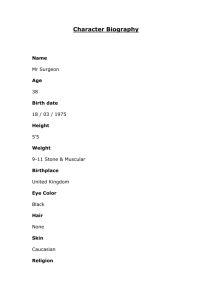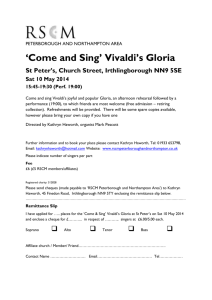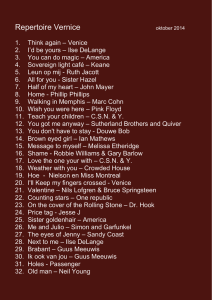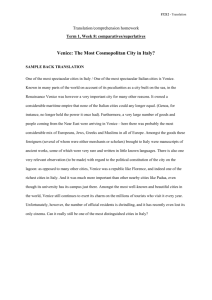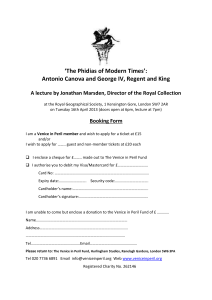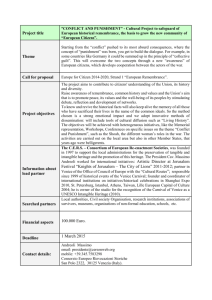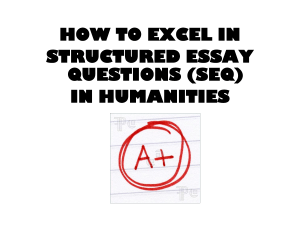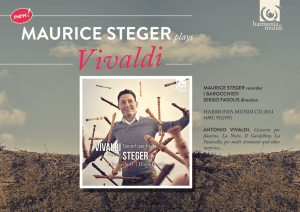Vivaldi`s Ring of Mystery
advertisement
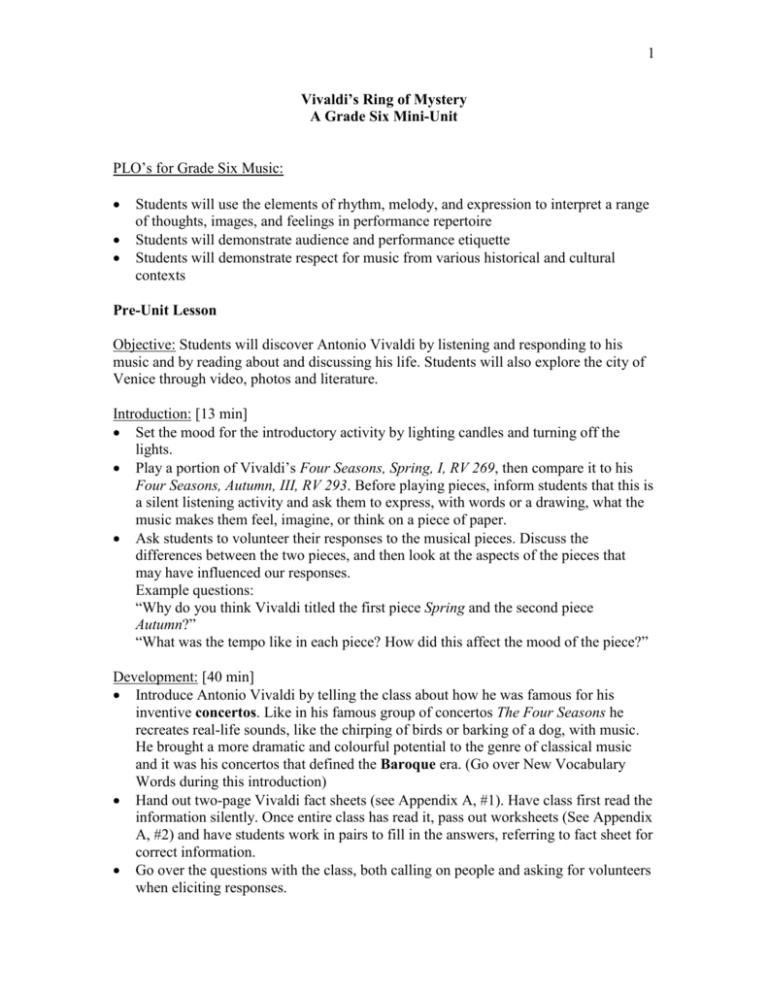
1 Vivaldi’s Ring of Mystery A Grade Six Mini-Unit PLO’s for Grade Six Music: Students will use the elements of rhythm, melody, and expression to interpret a range of thoughts, images, and feelings in performance repertoire Students will demonstrate audience and performance etiquette Students will demonstrate respect for music from various historical and cultural contexts Pre-Unit Lesson Objective: Students will discover Antonio Vivaldi by listening and responding to his music and by reading about and discussing his life. Students will also explore the city of Venice through video, photos and literature. Introduction: [13 min] Set the mood for the introductory activity by lighting candles and turning off the lights. Play a portion of Vivaldi’s Four Seasons, Spring, I, RV 269, then compare it to his Four Seasons, Autumn, III, RV 293. Before playing pieces, inform students that this is a silent listening activity and ask them to express, with words or a drawing, what the music makes them feel, imagine, or think on a piece of paper. Ask students to volunteer their responses to the musical pieces. Discuss the differences between the two pieces, and then look at the aspects of the pieces that may have influenced our responses. Example questions: “Why do you think Vivaldi titled the first piece Spring and the second piece Autumn?” “What was the tempo like in each piece? How did this affect the mood of the piece?” Development: [40 min] Introduce Antonio Vivaldi by telling the class about how he was famous for his inventive concertos. Like in his famous group of concertos The Four Seasons he recreates real-life sounds, like the chirping of birds or barking of a dog, with music. He brought a more dramatic and colourful potential to the genre of classical music and it was his concertos that defined the Baroque era. (Go over New Vocabulary Words during this introduction) Hand out two-page Vivaldi fact sheets (see Appendix A, #1). Have class first read the information silently. Once entire class has read it, pass out worksheets (See Appendix A, #2) and have students work in pairs to fill in the answers, referring to fact sheet for correct information. Go over the questions with the class, both calling on people and asking for volunteers when eliciting responses. 2 Show either various overheads of photos of Venice, or show a short clip from a video about Venice. If time permits, read a short story that describes the city (see Resources below). Ask students if anyone has been to or heard stories about Venice before. Closure: [7 min] Explain that next class we will be going on a magical adventure to the city of Venice, and we will even get to meet the famous composer that we have learned about today, Antonio Vivaldi. Ask students some questions about today’s lesson: “Can anyone remember what the names of the two pieces were that we listened to?” “Can someone describe to me some examples of what makes a musical piece a concerto?” “Without looking at your worksheets, what are some things we learned today about Vivaldi?” “What are some unique features of Venice?” Evaluation: Were the responses to the musical pieces accurate? Were they good listeners? Did they fill in Vivaldi worksheets? Did they participate in class discussions? Did they answer the closure review questions properly? Resources: Rossi, R. (2004). Venice. New York: Enchanted Lions Books. illustrations of Venice No producer given. (1994). Venice. San Ramon: International Video Network. 30 min. video on Venice No producer given. (1987). Venice: Queen of the Adriatic. New York: V.I.E.W Video art series. 30 min. video McCully, E. A. (2001). The Orphan Singer. New York: Arthur A. Levine Books. fictional book with beautiful illustrations, ties in theme of orphaned children Talley, C. (1992). Papa Piccolo. Kansas City: MarshMedia. a Venice adventure through the eyes of a cat, deals with orphaned kittens New Vocabulary Words: -Concertos -Baroque 3 Lesson 1 Objective: Students will create Carnival masks and discuss the history behind this magnificent festival. Students will listen to the first two scenes of Vivaldi’s Ring of Mystery and then reflect on what they heard. They will also apply their previous knowledge of rhythm and melody when looking at one of the musical pieces in the story. Introduction: [5 min] “As I said last class, today we are going to embark on a magical and mysterious adventure to the city of Venice, Italy. Can anyone tell me some things we learned about Venice? We are going to meet a young girl, probably about your age, named Katarina, as she arrives in Venice for the first time. What was the name of the piece we heard last class, and who wrote it? I want you to keep in mind the images of Venice and music and information of Antonio Vivaldi that we learned last class as we listen to the story. It is entitled Vivaldi’s Ring of Mystery…” Development: [50 min] Play the first scene of the story, up until Katarina knocks on the door of the Pietà. [End of track 2] Pause CD and discuss the students’ opinions and thoughts about the Carnival. Show various overhead pictures of paintings or photos or costumes of the Carnival in Venice (See Resources below). While showing pictures, tell students historical information about Carnival. Play the second scene of the story, up until Katarina says, “Climb up to the window.” [End of track 6] [Approximate total running time: 15 min] Discuss the sad story of the Duke with the class. Ask questions like “How would you feel if you lost someone you care for? Why did the Duke chose the violin to help him find his long lost grandchild?” Play the first few bars of Winter, II on the piano (See Appendix A, #3), which is the song playing when Vivaldi tells the girls about the Duke’s story. Repeat the melody, first asking to students to listen for the rhythm. After playing the first few bars a couple times, see if anyone is able to show the rhythm and beat using TA and TI TI visual representations on the board. Ask for several volunteers. Once class has figured out the rhythm, split class in half and have half clap the rhythm and other half stomp the 4-count beat. Discuss how the pitch effects the mood of the song (notes going high to low), and how music can lend itself to the ambiance of a story. Tell the class that, on a lighter note, we are going to make our own masks for the Carnival! Bring in examples of some pre-made masks and show pictures of popular Carnival-style masks in order to give students ideas. Explain the criteria for creating masks (creativity, appropriateness [ie: no Spiderman masks], workmanship). Have students sit in groups of five, with a bin of decorating supplies for each group. Hand out plastic masks (can be bought at art supply stores). Play some of Vivaldi’s music 4 while students are creating masks. Students can continue to work on masks in Art class if more time is needed. Closure: [5 min] Ask students to summarize the story of Vivaldi’s Ring of Mystery so far. Discuss the title of the story and possible predictions: “What is the ring of mystery? Why might the ring be mysterious? Does anyone have a prediction of what may happen next?” Evaluation: Were students participating in class discussions after each listening period? Could class work together to clap and stomp the rhythm and beat of the Winter piece properly? Did they understand and apply the concepts of rhythm and pitch? Did students adhere to the criteria for mask making? Were they good listeners? Resources: www.carnivalofvenice.com Carnival website, full of information with some illustrations www.venicecarnival.com/discover.htm no information but beautiful and vivid pictures 5 Lesson 2 Objective: Students will listen to scenes three and four of Vivaldi’s Ring of Mystery, and then create their own mini-opera, by writing lyrics to go to an already familiar melody and by improvising an instrumental accompaniment. They will also write poetry that was inspired by the somber music in the storm scene of the story. Introduction: [7 min] “Remember when we discussed last class how music can lend itself to a story, adding to the effect of the literature? Well, we are going to continue to look at that idea, but first we have to go back to Venice. Can anyone remind me what has happened to Katarina so far on her adventure in Venice?” Development: [43 min] Play scene three of the story [Track 7-9]. Pause CD to get questions and comments from students. Review the scene where Vivaldi turns an argument between two girls into an opera. Explain to class what makes an opera. An opera is a libretto (See Vocabulary words) that is acted and sung by one or more singers, with instrumental accompaniment. We are going to create our own mini-opera. As a class, we decide what will be the storyline of the opera. It should contain some climactic build-up. The class decides on one of the melodies from our class repertoire, in order to have music, from which to accompany lyrics. As a class, we create the libretto that will be sung in our opera, then split the class into groups so that each group will sing a different verse from the melody, as though they are singers in an opera. Determine where groups will stand on our mini-stage (the classroom floor) as well as any props or stage direction that will occur. Get volunteers to play various rhythms on instruments, choosing appropriate instrumentation that will add to the mood of our mini-opera. Rehearse and go over the verses and instrumentation, conducting the groups, before doing one final, uninterrupted performance. Voila …an opera is made! Play scene four [Track 10-11]. Ask questions to stimulate discussion and reinforce comprehension. Example questions: “What did we learn about Venice?” “Do you think it is possible that Venice could ever sink?” “What did you notice about the music in the first scene we listened to today, when Katarina and Giovanni were taking a trip into town to get the violin repaired?” Replay if necessary. “How did the music change when they were on their way to visit the Island of the Dead compared to when they were leaving the Island?” “Why would someone want to steal that particular violin?” “Can anyone interpret what the lines of the poem, which the mysterious masked man left, mean?” 6 Closure: [10 min] Play the last minute of scene four [Track 11, 2:25-3:36] again, which is the storm scene. Before playing it, ask students to listen to how the musical piece suggests a storm. Play this piece (Four Seasons, Summer, III, RV 315) on its own, while students write a poem or lyric to accompany that piece. Given that the title of the piece is Summer, encourage students to use their imagination when listening because there is more than one way to interpret the music. Ask everyone to hand in his or her poem or lyrics when the piece has finished. Evaluation: How well did students answer comprehension questions? Did students participate, pay attention, volunteer good ideas, and work cooperatively during the mini opera activity? Do the poems or lyrics meet the classes already determined criteria for good writing? Were they good listeners? New Vocabulary Words: -Libretto 7 Lesson 3 Objective: Students will listen to the final two scenes of Vivaldi’s Ring of Mystery and then sing the Gondlier’s Song. They will participate in discussion about the story and write their own sequels to the story. As a culminating activity, students will wear their Carnival masks while listening to the more upbeat music of Vivaldi and enjoying the Italian favourite: gelato. Introduction: [6 min] Dim the lights, light a candle, and play Four Seasons, Summer, III, RV 315. Read excerpts from the students’ poems or lyrics that they wrote last class, without identifying any of the authors. When song is finished, hand back the marked poems. Ask how the music effected the reading of the poems. Ask students to summarize the story so far. Development: [45 min] Play scene five [Track 12]. Pause CD to discuss the song that Giovanni is singing at the end of the scene. Display song on overhead and begin by singing the song a couple times for the class (See Appendix A, #4). Have the class get into their singing positions (pre-determined proper singing posture) and then sing the song together. Discuss the meter and have class tap the beat as we sing. Finish by playing piano accompaniment for last couple of singings. Play scene six [Track 13-14]. Ask questions to elicit discussion: “What are your favorite or least favorite parts of the story?” “Did anyone guess that Katarina was the Duke’s missing grandchild? At one point did you figure it out?” “When did the mysterious masked stranger appear in the story? Did anyone guess that it was Vivaldi?” “What are some other stories that we know about orphans?” “Why did Vivaldi choose to stay and teach the girls music when he was famous and could do whatever he wanted? What are some things that you are passionate about? Would you continue to pursue that passion even if you had all the wealth in the world?” Ask the students to brainstorm what they think happened next. Does Katarina continue to play her music. Does she have any brothers or sisters? What about Vivaldi and the magic violin? Have students write one page sequels to Vivaldi’s Ring of Mystery. They can continue the writing assingment in Language Arts class or take home as homework. Closure: [10 min] Bring out the students’ masks from lesson one. Tell the class that we are going to have our own Venician celebration, with masks and music and a special Italian surprise. Play Picollo Concerto, I, RV 443, and then bring out the gelato! 8 Evaluation: How well did the class sing the Gondolier’s Song? Did they understand the concepts of meter and rhythm moving to a steady beat? Did they show comprehension of the story during discussion? Did the one page sequels meet the pre-determined good writing criteria? Were they good listeners? 9 Appendix A 1. Two-page Vivaldi fact sheet Taken from http://www.nac-cna.ca/canadatour1999/english/kidszone/KidsKit.pdf 2. Fact finding work sheet 3. Winter, II, RV 297 Taken from Susan Hammond’s Classical Kids Teacher’s Notes for Vivaldi’s Ring of Mystery. ISBN 1895404282 4. Gondolier’s Song Taken from Susan Hammond’s Classical Kids Teacher’s Notes for Vivaldi’s Ring of Mystery. ISBN 189540428
